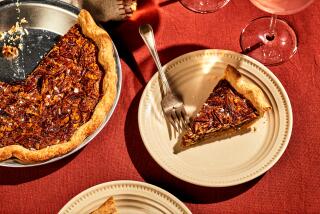Some Tips for Making the Perfect Meringue
- Share via
Question: Everyone considers me to be an excellent cook, especially my husband. You can imagine in 40 years of cooking, I’ve learned a lot, but I’ve never learned the secret of making a good meringue on my lemon meringue pies. When I take the pie from the oven it looks beautiful, but in a few minutes it wrinkles and shrinks. Please tell me how to make a pie I’ll be proud to serve.
Answer: The following recipe was developed by Sunkist Growers Inc., using research on making lemon meringue pies that the citrus cooperative sponsored at California State College at Los Angeles.
FRESH LEMON MERINGUE PIE
1 1/2 cups plus 6 tablespoons sugar
1/4 cup plus 2 tablespoons cornstarch
1/4 teaspoon salt
1/2 cup cold water
1/2 cup fresh lemon juice
3 eggs, separated
2 tablespoons butter or margarine
1 1/2 cups boiling water
1 teaspoon grated lemon peel
Few drops yellow food color
1 (9-inch) baked pie shell
1/4 teaspoon cream of tartar
Using wire whisk, combine 1 1/2 cups sugar, cornstarch and salt in large saucepan. Gradually whisk in cold water, then lemon juice until smooth. Add beaten egg yolks, blending very thoroughly. Add butter.
Add boiling water gradually, stirring constantly with rubber spatula. Gradually bring mixture to full boil, stirring gently and constantly with spatula over medium to high heat. Reduce heat slightly as mixture begins to thicken. Boil slowly 1 minute.
Remove from heat and stir in grated lemon peel and food color. Pour hot filling into baked pastry shell. Let stand, allowing thin film to form while preparing meringue.
Have egg whites at room temperature. Use small, deep bowl and beat with electric mixer several seconds until frothy (some fairly large air cells still remain). Add cream of tartar. Beat on high speed until whites have just lost foamy appearance and bend over slightly when beaters are withdrawn, forming soft peaks.
Reduce speed to medium while gradually adding remaining 6 tablespoons sugar, about 1 tablespoon at time. Return to high speed and beat until whites are fairly stiff but still glossy and soft peaks are again formed when beaters are withdrawn.
Place meringue on hot filling in several mounds around edge of pie. Using narrow spatula, push meringue gently against inner edge of pie crust, sealing well. Cover rest of filling by swirling meringue from edge of pie to center, forming decorative peaks with spatula.
Bake at 350 degrees 12 to 15 minutes until golden brown. Cool on wire rack at room temperature away from drafts 2 hours before cutting and serving. To ensure clean cut, use sharp knife and dip into hot water after each cut. Makes 6 to 8 servings.
Sunkist also shares the following guidelines from its research. For a tall and tender meringue, the “bowl and beaters must be free of any grease or oil. The tiniest speck of fatty substance causes great volume loss.
“Beaten egg whites reach maximum volume when whites are at room temperature. The early addition of cream of tartar stabilizes the egg whites. The cell walls become stronger, permitting them to hold more air without breaking down. If cream of tartar is old or not available, substitute 1 teaspoon of fresh squeezed lemon juice for 1/4 teaspoon cream of tartar. Contrary to popular belief, salt actually lowers the stability of egg whites.
“The amount of beating before and after adding the sugar is a key factor in creating a successful meringue. Beating whites only to the soft peak stage before and after adding sugar can help prevent such common meringue problems as beading, weeping, slipping and dryness. The key here is soft peak. The term stiff but not dry , commonly used in many recipes, is one stage beyond soft peak and will not give you a tender perfect meringue. Practice makes perfect. It won’t take long to know the just right stages for adding sugar and beating.”
More to Read
Eat your way across L.A.
Get our weekly Tasting Notes newsletter for reviews, news and more.
You may occasionally receive promotional content from the Los Angeles Times.










